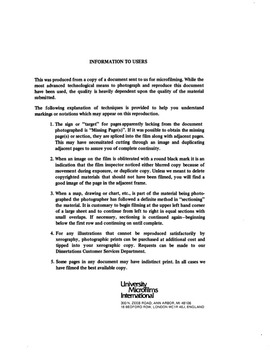| dc.contributor.author | Raburn, Josephine, | en_US |
| dc.date.accessioned | 2013-08-16T12:28:21Z | |
| dc.date.available | 2013-08-16T12:28:21Z | |
| dc.date.issued | 1981 | en_US |
| dc.identifier.uri | https://hdl.handle.net/11244/4871 | |
| dc.description.abstract | Five hundred university students were tested with Lowenfeld's SPT 1 to determine their perceptual type. From those students, 51 visual and 51 haptic females were chosen, were matched for handedness and musical ability, and were randomly assigned to three treatment groups. One group, "melody at presentation time, " had flute folk tunes accompany slides, and a flute background melody accompany a narrative paragraph on tape. This group was tested for recognition and recall of both the pictorial and the verbal information, but it did not have music at testing. A second group, "melody at both presentation and at testing time, " used the same slides and paragraph, but it had music throughout the experiment. A third group was a control group which saw the same slides, heard the same paragraph, and took the same tests but the group was without music at any time. | en_US |
| dc.description.abstract | Results of this experiment show that both visual and haptic individuals are helped significantly by music when the task is pictorial recognition or pictorial recall. It was also found that music played concurrently with the presentation of pictorial material, but not at testing time, is the best condition for both perceptual types. It was further noted that in the presence of music, the scores of haptic individuals are raised almost to the level of visual individuals in both recognition and recall of pictorial information. In addition, haptics are relatively unaffected by music in the performance of verbal tasks, but visuals are significantly distracted by it in both recognition and recall of verbal information. Since support was provided for Paivio's dual processing theory, educators are encouraged to be cautious about the use of music with verbal presentations. | en_US |
| dc.description.abstract | Investigation into the effects of melody on ability of visual and haptic learners to recognize and recall pictorial and verbal patterns in meaningful materials also looked for evidence supporting Paivio's dual channel information processing theory. | en_US |
| dc.format.extent | viii, 205 leaves : | en_US |
| dc.subject | Education, Educational Psychology. | en_US |
| dc.title | Relationship of melody and perceptual type to performance on recognition and recall tasks. | en_US |
| dc.type | Thesis | en_US |
| dc.thesis.degree | Ph.D. | en_US |
| dc.thesis.degreeDiscipline | Jeannine Rainbolt College of Education | en_US |
| dc.note | Source: Dissertation Abstracts International, Volume: 42-02, Section: A, page: 0619. | en_US |
| ou.identifier | (UMI)AAI8116762 | en_US |
| ou.group | Jeannine Rainbolt College of Education | |
